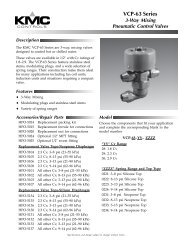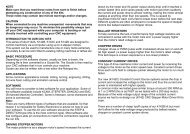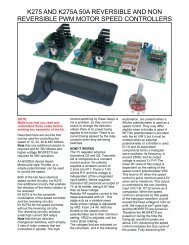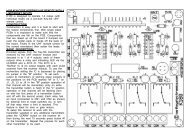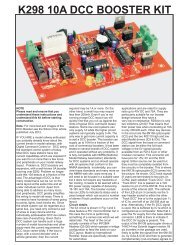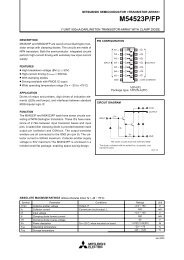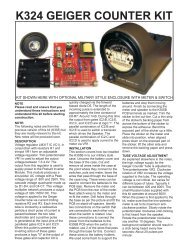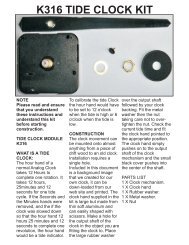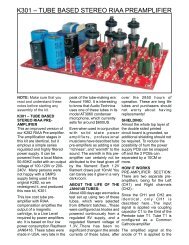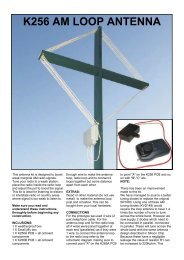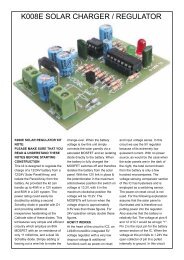RX-3302D/RX-4303D/RXF-4303D RF Receiver ... - Oatley Electronics
RX-3302D/RX-4303D/RXF-4303D RF Receiver ... - Oatley Electronics
RX-3302D/RX-4303D/RXF-4303D RF Receiver ... - Oatley Electronics
- No tags were found...
You also want an ePaper? Increase the reach of your titles
YUMPU automatically turns print PDFs into web optimized ePapers that Google loves.
<strong>RX</strong>-<strong>3302D</strong>/<strong>RX</strong>-<strong>4303D</strong>/<strong>RX</strong>F-<strong>4303D</strong> <strong>RF</strong> <strong>Receiver</strong> W/DecoderManual1. Introduction<strong>RX</strong>-<strong>3302D</strong> is a radio frequency super-regenerative receiver module which can facilitate the OEMdesigners to design their applications in remote control in the quickest way. The circuit is designed withSMD components and the module size is small enough to be able to be fitted in almost any application.There are the following versions:1) <strong>RX</strong>-<strong>3302D</strong>2 /<strong>RX</strong>-<strong>4303D</strong>2 /<strong>RX</strong>F-<strong>4303D</strong>2: For 2-button transmitters.There are versions as follows:<strong>RX</strong>-<strong>3302D</strong>2: Super-regenerative, AM<strong>RX</strong>-<strong>4303D</strong>2: Super-heterodyne, AM<strong>RX</strong>F-<strong>4303D</strong>2: Super-heterodyne, FM2) <strong>RX</strong>-<strong>3302D</strong>4 /<strong>RX</strong>-<strong>4303D</strong>3 /<strong>RX</strong>F-<strong>4303D</strong>4: For 2 or 4 button transmitters.There are 3 more pins than version which are:Pin # 9: VPP, for factory programming only. No connection is needed.Pin #10: D2, for button #3Pin #11: D3 , for button #4There are versions as follows:<strong>RX</strong>-<strong>3302D</strong>4: Super-regenerative, AM<strong>RX</strong>-<strong>4303D</strong>4: Super-heterodyne, AM<strong>RX</strong>F-<strong>4303D</strong>4: Super-heterodyne, FMD means decoder.For <strong>RX</strong>-<strong>3302D</strong>, <strong>RX</strong>-<strong>4303D</strong> and <strong>RX</strong>F-<strong>4303D</strong>, the decoder function has been implemented inthe on-board microprocessor. Besides, the code learning has also been implemented. Thus itrelieves the system’s design load on the remote control part totally.There are rolling code and fixed code variations which will be explained later.1
! <strong>RX</strong>-<strong>3302D</strong>2 is an <strong>RF</strong> module with the following pin-outs and dimension:+ Note that all the pin-outs #1 ~ #8; # 12~ #13 are compatible with those of <strong>RX</strong>-3302R so thatyou can replace <strong>RX</strong>-3302R completely if the size allows.PIN 1 : GNDPIN 3 : VCC (5V DC)PIN 5 : Valid TimePIN 7 : Learning AcknowledgePIN 12 : ANT (Antenna)PIN 2 : Digital OutputPIN 4 : Linear Output (For Testing)PIN 6 : D0PIN 8 : D1PIN 13 : GNDDimension of <strong>RX</strong>-<strong>3302D</strong>2: 56.5 mm X 19.5 mmDimension of <strong>RX</strong>-3302R: 53.5 mm X 18.0 mmDimension of <strong>RX</strong>(F)-<strong>4303D</strong>: 60.2 mm X 22.8 mm2
! <strong>RX</strong>-<strong>3302D</strong>4/<strong>RX</strong>(F)-<strong>4303D</strong>4 is an <strong>RF</strong> module with the following pin-outs and dimension:PIN 1 : GNDPIN 2 : Digital OutputPIN 3 : VCC (5V DC)PIN 4 : Linear Output (For Testing)PIN 5 : Valid Time, for 2A1 version, don’t careFor 2Q1 version, this pin can be connected to a boozer so that it can indicate if codelearning is successful. This application will be very convenient if the control receiverunit is installed a hidden place.PIN 6 : D0PIN 7 : Learning Acknowledge PIN 8 : D1PIN 9 : VPP, for factory programming only, no connection.PIN 10 : D2PIN 11 : D3PIN 12 : ANT (Antenna)PIN 13 : GNDDimension of <strong>RX</strong>-<strong>3302D</strong>4: 56.5 mm X 19.5 mmDimension of <strong>RX</strong>(F)-<strong>4303D</strong>4: 60.2 mm X 22.8 mm3
" Comparison Table: (Versus our <strong>RX</strong> Series)Model SR/SHmodePOWER CPU+EEPROMSENSITIVITY POWERCONSUMPTION<strong>RX</strong>-3302 SR +5V DC --- - 102dBm 1.8mA AMModulation<strong>RX</strong>-3302L SR +5V DC --- - 100dBm 0.33 mA AM<strong>RX</strong>-3304 SR +5V DC --- - 100dBm 2.7mA AM<strong>RX</strong>-3302R/F SR +5V DC YES - 105dBm 3.1mA AM<strong>RX</strong>-<strong>3302D</strong> SR +5V DC YES - 105dBm 2.7mA AM<strong>RX</strong>-<strong>4303D</strong> SH +5V DC --- - 110dBm 5.1mA AM<strong>RX</strong>F-<strong>4303D</strong> SH +5V DC YES - 110dBm 6.2mA FMNote:SR: Super-Regenerative SH: Super-HeterodyneAM: Amplitude Modulation2. Functionality Difference:There are 2 major application types involved:2.1 For rolling code application:! <strong>RX</strong>-<strong>3302D</strong>/<strong>RX</strong>(F)-<strong>4303D</strong><strong>RX</strong>-<strong>3302D</strong> or <strong>RX</strong>(F)-<strong>4303D</strong> includes the decoder CPU (PIC16C505) and the EEPROM (93C46 or93C56 or 93C66 or 93LC76 or 93LC86) on board. The code learning has been built in.The main microprocessor can be programmed transparently without caring about the code learningand the rolling code.For <strong>RX</strong>-<strong>3302D</strong>, there are following models for rolling code (2A1):For 2-button rolling code transmitters (A1 type) :# <strong>RX</strong>-<strong>3302D</strong>2-15 (for 15 users, W / 93C46)# <strong>RX</strong>-<strong>3302D</strong>2-63 (for 63 users, W / 93C66)# <strong>RX</strong>-<strong>3302D</strong>2-127 (for 127 users, W / 93LC76).# <strong>RX</strong>-<strong>3302D</strong>2-255 (for 255 users, W / 93LC86).Above two models work with only 2-button rolling code transmitters (A1) from Automicro.4
For 2 or 4-button rolling code transmitters (A1 type):TX-4311R, TX-4312R, TX-4313R# <strong>RX</strong>-<strong>3302D</strong>4-15 (for 15 users, W / 93C46).# <strong>RX</strong>-<strong>3302D</strong>4-31 (for 31 users, W / 93C56).# <strong>RX</strong>-<strong>3302D</strong>4-63 (for 63 users, W / 93C66).# <strong>RX</strong>-<strong>3302D</strong>4-127 (for 127 users, W / 93LC76).# <strong>RX</strong>-<strong>3302D</strong>4-255 (for 255 users, W / 93LC86).All AM rolling code transmitters with 2~4 buttons from Automicro with A1 label can work with <strong>RX</strong>-<strong>3302D</strong>.For <strong>RX</strong>-<strong>4303D</strong>, there are 4 models for AM rolling code (2A1) receivers:For 2-button FM rolling code transmitters (A1 type) : TX-3315S# <strong>RX</strong>-<strong>4303D</strong>2-15 (for 15 users, W / 93C46)# <strong>RX</strong>-<strong>4303D</strong>2-63 (for 63 users, W / 93C66)# <strong>RX</strong>-<strong>4303D</strong>2-127 (for 127 users, W / 93LC76).# <strong>RX</strong>-<strong>4303D</strong>2-255 (for 255 users, W / 93LC86).Above models work with only 2-button rolling code SAW AM transmitters (A1) fromAutomicro.For 2 or 4-button AM rolling code transmitters (A1 type): TX-4312RS# <strong>RX</strong>-<strong>4303D</strong>4-15 (for 15 users, W / 93C46)# <strong>RX</strong>-<strong>4303D</strong>4-63 (for 63 users, W / 93C66)# <strong>RX</strong>-<strong>4303D</strong>4-127 (for 127 users, W / 93LC76).# <strong>RX</strong>-<strong>4303D</strong>4-255 (for 255 users, W / 93LC86).For <strong>RX</strong>F-<strong>4303D</strong>2, there are 4 models for FM rolling code (2A1) receivers:For 2-button FM rolling code transmitters (A1 type) : TXF-3313R# <strong>RX</strong>F-<strong>4303D</strong>2-15 (for 15 users, W / 93C46)# <strong>RX</strong>F-<strong>4303D</strong>2-63 (for 63 users, W / 93C66)# <strong>RX</strong>F-<strong>4303D</strong>2-127 (for 127 users, W / 93LC76).# <strong>RX</strong>F-<strong>4303D</strong>2-255 (for 255 users, W / 93LC86).For 2 or 4-button FM rolling code transmitters (A1 type):TXF-3313R, TXF-4311R# <strong>RX</strong>-<strong>4303D</strong>4-15 (for 15 users, W / 93C46)# <strong>RX</strong>-<strong>4303D</strong>4-63 (for 63 users, W / 93C66)# <strong>RX</strong>-<strong>4303D</strong>4-127 (for 127 users, W / 93LC76).# <strong>RX</strong>-<strong>4303D</strong>4-255 (for 255 users, W / 93LC86).5
! Frequency Bandwidth<strong>RX</strong>-<strong>3302D</strong>: 434MHz, LRC, 4MHz Bandwidth.<strong>RX</strong>-<strong>4303D</strong>: 433.92MHz, SAW, 0.5MHz Bandwidth.<strong>RX</strong>F-<strong>4303D</strong>: 433.92MHz, SAW, 0.6MHz Bandwidth.! Programming the Main Microprocessor and <strong>RX</strong>-<strong>3302D</strong>/<strong>RX</strong>(F)-<strong>4303D</strong>:1. For rolling code:Using TX-3315 (S) / TX-3312R / TX(F)-3313R /TX-3316R (W / HCS-200 orHCS-301 from Microchip, programmed with our version A1) with twobuttons but 3 commands available.VT D0 D1When button #1 is being pressed Don’t Care HIGH LOWWhen button #2 is being pressed Don’t Care LOW HIGHWhen button #1 & #2 are beingpressedDon’t Care HIGH HIGHD0 and D1 will become HIGH as long as the proper button is being pressed, i.e., D0 will be HIGH ifbutton #1 is being pressed and D1 will be HIGH if button #2 is being pressed. VT will be HIGH aslong as any of D0 or D1 is HIGH, but VT can be ignored by the programming.! Programming the Main Microprocessor using <strong>RX</strong>-<strong>3302D</strong> /<strong>RX</strong>(F)-<strong>4303D</strong>and TX(F)-4311R / TX-4313R /TX-4312R(S) (W / HCS-301 from Microchip,programmed with version A1) of 4-button transmitter, there are extraseven double-button commands available in addition to four singlebuttoncommands.VT D0 D1 D2 D3When button #1 is being pressed Don’t Care HIGH LOW LOW LOWWhen button #2 is being pressed Don’t Care LOW HIGH LOW LOWWhen button #3 is being pressed Don’t Care LOW LOW HIGH LOWWhen button #4 is being pressed Don’t Care LOW LOW LOW HIGHWhen button #1 and #2 are being pressed Don’t Care HIGH HIGH LOW LOWWhen button #1 and #3 are being pressed Don’t Care HIGH LOW HIGH LOWWhen button #1 and #4 are being pressed Don’t Care HIGH LOW LOW HIGH6
When button #2 and #3 are being pressed Don’t Care LOW HIGH HIGH LOWWhen button #2 and #4 are being pressed Don’t Care LOW HIGH LOW HIGHWhen button #3 and #4 are being pressed Don’t Care LOW LOW HIGH HIGHEach D0, D1,D2 or D3 will become HIGH as long as the proper button is being pressed. VT will beHIGH as long as any of D0 or D1 or D2 or D3 is HIGH, but VT can be ignored by the programming.+ Notes:For our rolling code transmitters, we have the following labels on the encoders (HCS200 or HCS300or HCS301):# A1: For <strong>RX</strong>-3302R/D, <strong>RX</strong>(F)-<strong>4303D</strong>, CS-04R2, CS-04R4, CS-281, CS-28, CS-20CR# B1: For CS-04R, CS-04G, CS-06! Learning Mode (For <strong>RX</strong>-<strong>3302D</strong>/<strong>RX</strong>(F)-<strong>4303D</strong>):The LA (Learning Acknowledge) pin will be at HIGH normally and acts as an input. If this pin is putto LOW temporarily by a tact switch, then it remains at LOW and becomes an output for 15 onlyseconds during which a transmitter code can be learned if button #1 of any of our applicabletransmitters is pressed. After 15 seconds of period expires, then this pin restores to HIGH again.+ Note that only button #1 can be used for code learning.7
Learning acknowledge pin (LAP) pulled lowEnter learning mode & LAP is changed asoutput pin & output becomes low15 sec time-out?Yes15 sec time outValid transmitter #1 is pressedNoExitCompare with codes learnedVT goes high temporarily & 1 learning completedNoLearn code 64 th now?YesFirst in first outIf 15 seconds of period is not long enough for learning all the transmitters, then the 2nd or the 3rd cycleof learning can be done until all the transmitters (up to 15 or 31 or 63 or 127 or 225 depending on whichmodel of <strong>RX</strong>-<strong>3302D</strong>) is learned.If you want to erase all the transmitters learned, then please put the LA (Learning Acknowledge) pin toLOW for more than 10 seconds, then all the prior codes learned will be erased completely.$ Note that if the same transmitter is learned twice, it will be treated as only one transmitter withoutwasting any of the memory slot.Regarding synchronization between <strong>RX</strong>-<strong>3302D</strong>/<strong>RX</strong>-<strong>4303D</strong> and each rolling-code transmitter, if morethan 16 times that the receiver has not received the signals transmitted from each rolling-codetransmitter, then the receiver needs one extra signal from the transmitter for synchronization.8
$ Note that there are the following software versions for the rolling code models:1. 2A12. 2B3: Pressing two buttons of any transmitter learned earlier for more than 4 seconds, then thesystem will enter transmitter code learning mode.3. 2B4: This version can use pin #5 (VT) instead of pin #7 (LA) for indicating the code learningprocess. Pin #5 can be connected to a boozer via a transistor so that it can faciliate the codelearning process as follows:3.1 Press the learn button, then the boozer beeps once indicating that 15 seconds of codelearning process starts.3.2 Press any unlearned transmitter will beep the boozer as long as the button is being pressed.3.3 Up to 15 transmitters can be learned in one or more learning cycles for the 15-user version.3.4 If more than 15 transmitters are learned, then FIFO happens which means that the 16 thlearned transmitter will replace the first transmitter learned.3.5 When 15 seconds of learning cycle ends, the boozer will beep twice.3.6 You can delete all the codes learned earlier by pressing the learning button for more than 8.3seconds and the boozer will beep three times.3.7 You can press both buttons of any transmitter learned earlier for more than 4 seconds, thenthe system will enter the transmitter code learning cycle.2.2 For fixed code application:For <strong>RX</strong>-<strong>3302D</strong> with fixed code version, there are 5 models for either 2-buttonor 4-button transmitters:For 2-button transmitters (2C1):• <strong>RX</strong>-<strong>3302D</strong>4-15 (2C1): 15 users• <strong>RX</strong>-<strong>3302D</strong>4-31 (2C1): 31 users• <strong>RX</strong>-<strong>3302D</strong>4-63 (2C1): 63 users• <strong>RX</strong>-<strong>3302D</strong>4-127 (2C1): 127 users• <strong>RX</strong>-<strong>3302D</strong>4-255 (2C1): 255 usersFor 4-button transmitters (4C1):• <strong>RX</strong>-<strong>3302D</strong>4-15 (4C1): 15 users• <strong>RX</strong>-<strong>3302D</strong>4-31 (4C1): 31 users• <strong>RX</strong>-<strong>3302D</strong>4-63 (4C1): 63 users• <strong>RX</strong>-<strong>3302D</strong>4-127 (4C1): 127 users• <strong>RX</strong>-<strong>3302D</strong>4-255 (4C1): 255 usersAll the 2-button fixed code transmitters (3 10 code combination ) from Automicrocan work with <strong>RX</strong>-<strong>3302D</strong>(2C1 series). All the 4-button transmitters fromAutomicro can work with <strong>RX</strong>-<strong>3302D</strong> (4C1 series).9
3. <strong>RX</strong>-<strong>3302D</strong>/<strong>RX</strong>(F)-<strong>4303D</strong> Features! Using Microchip hopping technology! Work with HCS series of encoders! Support two-button, 3 functions or 4-button, 11 functions transmitters.! Unique key generation algorithm for every customer.! No user programming required for the rolling code.! Up to 15 / 31/ 63 /127 / 255 transmitters can be learned.! On-chip 4 Mhz RC oscillator.! 16C505 SMD4. APPLICATIONS! Automotive remote entry systems! Automotive alarm systems! Automotive immobilizer! Gate and garage door openers! Electronic door locks! Identity tokens! Burglar alarm systems5. DescriptionsIn <strong>RX</strong>-<strong>3302D</strong>(2A1), the built-in 16C505 is a code hopping decoder designed for secure Remote KeylessEntry (RKE) systems. The <strong>RX</strong>-<strong>3302D</strong> utilizes the patented Microchip code hopping system and highsecurity learning mechanisms to make this a canned solution when used with our rolling-codetransmitters to implement a unidirectional remote control keyless entry system.The key generation algorithm is programmed into the 16C505 decoder in protected mode and can not beread out of the device. Transmitter keys and synchronization counter are stored in its external EEPROM(93C46 or 93C56 or 93C66 or 93LC76 or 93LC86).The <strong>RX</strong>-<strong>3302D</strong> operates over a range of 5.0 ~ 5.5 V. The decoder employs automatic baud rate. Thedecoder contains sophisticated error checking algorithm to ensure only valid codes are accepted andcorrect information are written into its external EEPROM.10
7. Simple Application Board (Optional)Application notes:1. The power circuit for VCC is recommended to use regulator such as 78L05 and a capacitor atleast 47uF to be used so that ripple can be reduced.2. If the microprocessor is working with high speed crystal, then <strong>RX</strong>-4303 or <strong>RX</strong>-<strong>4303D</strong> isrecommended because the radiation is too strong.11



